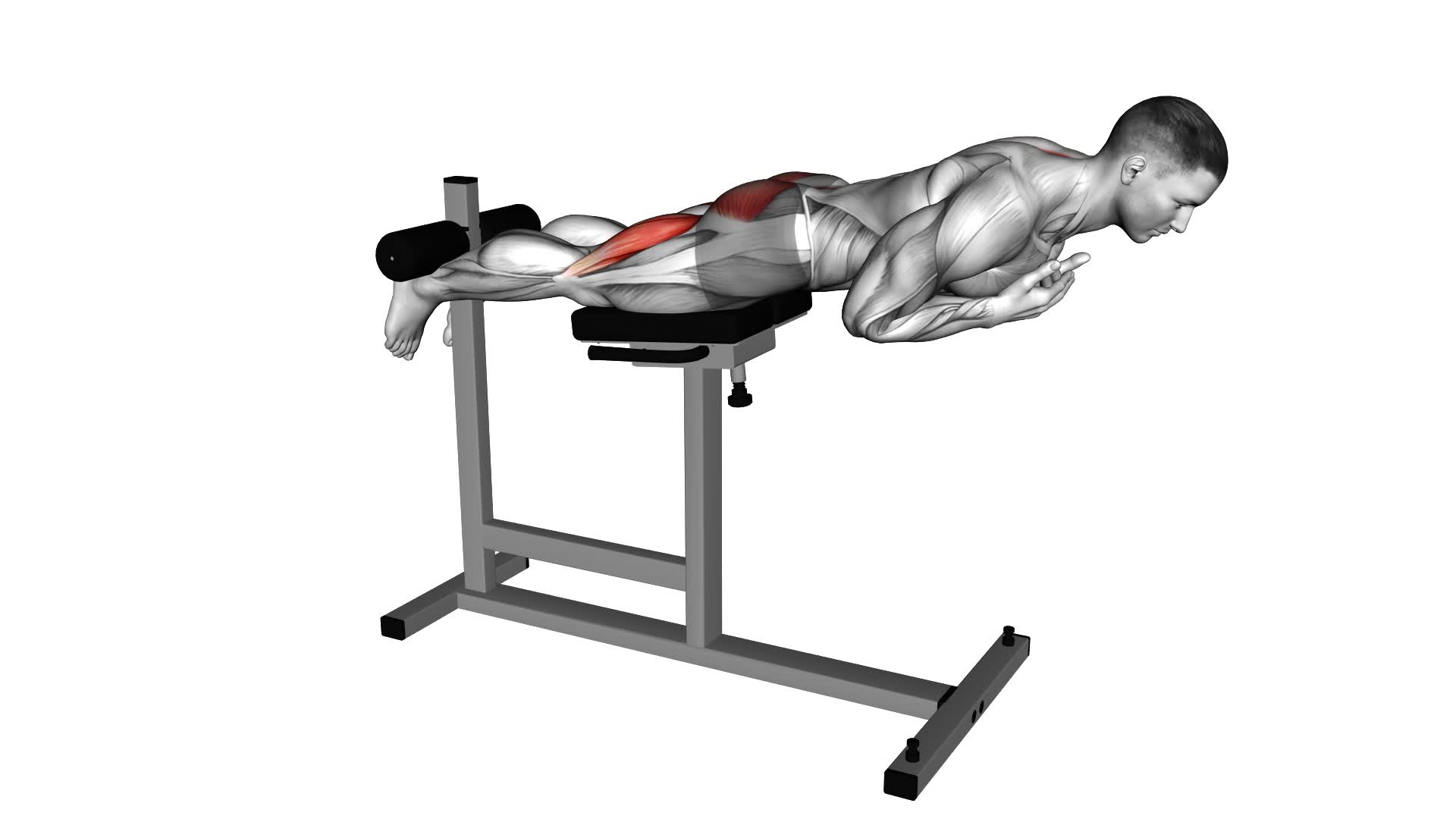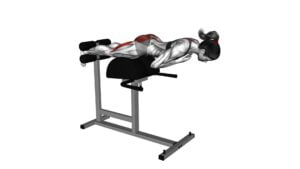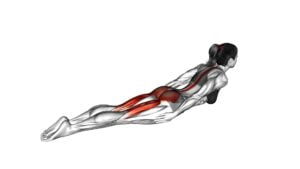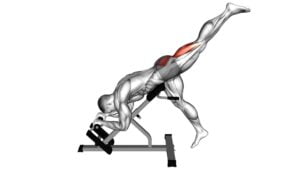Hyperextension (VERSION 2) – Video Exercise Guide & Tips

Are you looking for a way to strengthen your back and improve your posture? Look no further than hyperextension exercises.
Watch This Exercise Video
In this video exercise guide, we'll show you the proper form and variations of hyperextension, as well as common mistakes to avoid.
Plus, we'll share some valuable tips to help you get the most out of your hyperextension routine. Get ready to feel the burn and see results with this effective workout.
Let's get started!
Key Takeaways
- Hyperextension strengthens the lower back and improves posture.
- It is beneficial for desk workers and those with weak lower back muscles.
- Proper form is important, including aligning the body, engaging the core muscles, and keeping the glutes and hamstrings activated.
- Variations of hyperextension, such as weighted hyperextension and single-leg hyperextension, can be used to increase intensity.
Benefits of Hyperextension
To maximize the benefits of hyperextension, perform the exercise with proper form and engage your core muscles throughout.
Hyperextension is a highly effective exercise that strengthens your lower back and improves your posture. By targeting the muscles in your lower back, hyperextension helps to increase their strength and stability. This can be especially beneficial for individuals who have weak lower back muscles or those who spend long hours sitting at a desk.
Engaging your core muscles during hyperextension is crucial for maintaining proper form and maximizing the benefits of the exercise. Your core muscles, including your abdominals and obliques, work together with your lower back muscles to provide stability and support to your spine. By actively engaging these muscles, you can enhance the effectiveness of the exercise and protect your back from injury.
In addition to strengthening your lower back, hyperextension also helps to improve your posture. By targeting the muscles that support the spine, this exercise can help to correct imbalances and alignment issues that may be causing poor posture. Regularly incorporating hyperextension into your workout routine can help you develop a strong and stable back, leading to improved posture and reduced risk of back pain.
Proper Form for Hyperextension
Maintaining proper form is essential when performing hyperextensions to maximize their benefits and avoid injury. To ensure you're executing the hyperextension technique correctly, here are some key points to keep in mind:
- Position yourself on the hyperextension equipment with your feet securely locked in place and your upper thighs resting on the pad.
- Align your body in a straight line from head to toe, with your back and neck in a neutral position.
- Engage your core muscles and keep your glutes and hamstrings activated throughout the movement.
By following these guidelines, you can ensure that you're targeting the muscles in your lower back and glutes effectively while minimizing the risk of strain or injury. Remember, the hyperextension equipment is designed to support your body in a safe and stable position, so make sure to use it correctly to maintain proper form.
Now that you understand the importance of proper form, let's dive into the various variations of hyperextension exercises that can help you target different muscle groups and add variety to your workout routine.
Variations of Hyperextension
Now let's explore different variations of hyperextension exercises to target various muscle groups and add variety to your workout routine. Incorporating hyperextension variations into your routine can help you engage different muscles and challenge your body in new ways.
One variation is the weighted hyperextension, where you hold a weight plate or dumbbell against your chest while performing the exercise. This adds resistance and intensifies the workout, targeting your lower back, glutes, and hamstrings even more effectively.
Another advanced technique is the hyperextension with a twist. Instead of just lifting your upper body, you rotate your torso to the left or right at the top of the movement. This engages your obliques and further enhances core stability.
If you want to target your hamstrings and glutes specifically, you can try the single-leg hyperextension. This variation involves extending one leg straight back while performing the exercise, which increases the workload on the supporting leg and intensifies the contraction in the targeted muscles.
Remember to start with lighter weights and gradually increase the intensity as you become more comfortable and stronger. Always maintain proper form and listen to your body to avoid injury.
Incorporating these advanced hyperextension techniques into your routine can help you achieve better overall muscle development and functional strength.
Common Mistakes to Avoid in Hyperextension
One common mistake to avoid in hyperextension is not maintaining proper form and technique. When performing this exercise, it is crucial to focus on maintaining a neutral spine and avoiding excessive arching or rounding of the back.
Here are three common mistakes to watch out for and how to correct them:
- Rounding the back: One of the most common mistakes is rounding the back during hyperextension. This not only reduces the effectiveness of the exercise but also puts unnecessary stress on the spine. To avoid this, engage your core muscles and imagine lengthening your spine as you lift your upper body.
- Using momentum: Another mistake is using momentum to swing the body up and down. This not only takes away the focus from the targeted muscles but also increases the risk of injury. Instead, concentrate on controlled movements, using your back muscles to lift and lower your upper body.
- Overextending the neck: It is essential to keep your neck in a neutral position during hyperextension. Avoid the temptation to lift your head too far back or tuck your chin into your chest. Keep your gaze forward and your neck aligned with your spine.
Tips for Getting the Most Out of Hyperextension
To maximize the benefits of hyperextension, focus on incorporating these tips into your workout routine.
First and foremost, it's crucial to prioritize safety and prevent injuries during hyperextension exercises. Always start with a proper warm-up to prepare your muscles and joints for the workout. This can include light cardio exercises and dynamic stretches. Additionally, make sure to maintain proper form throughout the movement. Keep your core engaged and your back straight to avoid putting excessive stress on your spine.
As you become more experienced with hyperextension exercises, you can explore advanced techniques to challenge your body further. One option is to incorporate resistance by holding a weight plate against your chest or using resistance bands. This will increase the intensity of the exercise and help build strength in your lower back and glutes.
Another advanced technique is to perform hyperextensions on an unstable surface, such as a stability ball or balance board. This will engage your core even more as it works to stabilize your body during the movement.
Frequently Asked Questions
What Are the Potential Risks or Injuries Associated With Performing Hyperextensions?
When performing hyperextensions, there are potential risks and injuries you should be aware of.
Hyperextensions primarily target the lower back muscles, but if not done correctly, they can strain or sprain your back.
Other injuries that may occur include muscle imbalances, herniated discs, or even fractures in severe cases.
It's crucial to maintain proper form and start with lighter weights to reduce the risk of these injuries.
Can Hyperextensions Help Improve Posture and Alleviate Lower Back Pain?
Hyperextensions can indeed help improve posture and alleviate lower back pain. By strengthening the muscles in your lower back, hyperextensions promote better spinal alignment and stability.
The proper technique for hyperextensions involves lying face down on a hyperextension bench and slowly lifting your upper body while keeping your back straight. This exercise targets the erector spinae muscles, which play a crucial role in maintaining good posture and relieving lower back pain.
Are Hyperextensions Suitable for Beginners or Individuals With Limited Fitness Experience?
Hyperextensions are suitable for beginners or individuals with limited fitness experience. They're a great exercise for core strengthening and can provide numerous benefits for back health.
By performing hyperextensions, you can strengthen the muscles in your lower back, which can help alleviate lower back pain and improve your posture.
How Often Should Hyperextensions Be Performed in a Weekly Workout Routine?
Incorporating hyperextensions into your weekly workout routine is essential for building core strength. To maximize the benefits, it's recommended to perform hyperextensions at least two to three times a week. This frequency allows your muscles to adapt and grow stronger over time.
Hyperextensions specifically target the lower back, glutes, and hamstrings, making them an effective exercise for strengthening and stabilizing the core. Remember to start with proper form and gradually increase the intensity as you progress.
Are There Any Modifications or Alternative Exercises for Individuals Who Cannot Perform Traditional Hyperextensions Due to Physical Limitations?
If you can't do traditional hyperextensions because of physical limitations, don't worry. There are modifications and alternative exercises you can try.
Seated back extensions are a great option. They target your lower back while reducing strain on your spine.
Another alternative is reverse hyperextensions. These engage your glutes and hamstrings while also working your lower back.
Conclusion
In conclusion, hyperextension is an effective exercise that offers several benefits, including strengthening the lower back and improving posture. It's important to maintain proper form during hyperextension to prevent injury and maximize results.
Variations of the exercise can be incorporated to target different muscle groups. Avoid common mistakes such as using momentum or arching the back excessively. Remember to listen to your body and start with appropriate weights or resistance.
Follow these tips to make the most out of your hyperextension workouts.

Author
Years ago, the spark of my life’s passion ignited in my mind the moment I stepped into the local gym for the first time. The inaugural bead of perspiration, the initial endeavor, the very first surge of endorphins, and a sense of pride that washed over me post-workout marked the beginning of my deep-seated interest in strength sports, fitness, and sports nutrition. This very curiosity blossomed rapidly into a profound fascination, propelling me to earn a Master’s degree in Physical Education from the Academy of Physical Education in Krakow, followed by a Sports Manager diploma from the Jagiellonian University. My journey of growth led me to gain more specialized qualifications, such as being a certified personal trainer with a focus on sports dietetics, a lifeguard, and an instructor for wellness and corrective gymnastics. Theoretical knowledge paired seamlessly with practical experience, reinforcing my belief that the transformation of individuals under my guidance was also a reflection of my personal growth. This belief holds true even today. Each day, I strive to push the boundaries and explore new realms. These realms gently elevate me to greater heights. The unique combination of passion for my field and the continuous quest for growth fuels my drive to break new ground.







